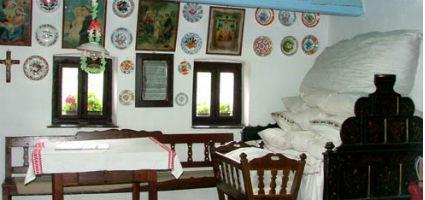2024. April 23. Tuesday
Village Museum of Hollókő - Hollókő
 |
Address: 3176, Hollókő Kossuth Lajos utca 82.
Phone number: (35) 300-168, (32) 379-043
Opening hours: 15.03-15.11.: Mon-Sun 10-18
|
The vernacular buildings of Ófalu, the villahe part of the World Heritage, recall the Palóc architecture of the beginning of the 20th century. The museum that used to be a dwelling house opposite the church in the center of the village functions since 1964.
The house was rebuilt in 1867 of the remains of the house that was destroyed by the fire of 1909. The building of three parts leaning on the slope of the hill is parallel to the street. There is a cellar in the front with a steps leading down from the street. The walls have stone base and were built of loam. The ridge-roof is covered with tile shingle. The small wooden facade has tiny ornaments on. In the line of the side walls there is a simple porch standing called `hambit` where the entrance to the house is situ-ated.
The peasant houses of the village reconstructed after their original looks have modern furniture. Our house has furniture recalling the life of the peasantry at the beginning of the 19th century. The exhibi-tion organized by the employees of the Palóc Museum of Balassagyarmat shows the life of a couple of medium financial status who lived with their parents and children.
When entering the house, we find ourselves in the room that also served as kitchen and porch. There are water balls on the bench next to the door, a table opposite to it with old style benches around it. Plates ornament the walls. The mouth of the furnace opens in the further corner. There are iron and ceramics dishes on it while the equipments of cooking are around it on the walls.
The room of the young couple looks into the street. The most spectacular furniture of the room is the bed covered with pillows. The bedcover and the bed were dowers of the bride. The inscription at the end of the bed says the date of the wedding and the name of the bride: "Fábián Erzsébet 1926". The chairs were put next to the wall when the cradle took their place. In the other corner of the room a bench surrounds the table. The cloths of the family were held in the drawer and the chest behind the door. The carpenter in Szécsény made most of the furniture. The little jugs, crosses and statues or-nament the top of another furniture. Besides the painted plates, pictures of saints ornamented the walls.
The door from the room leads to the chamber where the food of the family was kept. The wheat was kept in furniture that was no longer in use. The ceramic pots held the jelly and grease, the bread hung from the ceiling. The equipment and tools not in use were also kept in the chamber
The barrels in the cellar held the wine, the sour cabbage and the vine press was also kept in the chamber.
The house was rebuilt in 1867 of the remains of the house that was destroyed by the fire of 1909. The building of three parts leaning on the slope of the hill is parallel to the street. There is a cellar in the front with a steps leading down from the street. The walls have stone base and were built of loam. The ridge-roof is covered with tile shingle. The small wooden facade has tiny ornaments on. In the line of the side walls there is a simple porch standing called `hambit` where the entrance to the house is situ-ated.
The peasant houses of the village reconstructed after their original looks have modern furniture. Our house has furniture recalling the life of the peasantry at the beginning of the 19th century. The exhibi-tion organized by the employees of the Palóc Museum of Balassagyarmat shows the life of a couple of medium financial status who lived with their parents and children.
When entering the house, we find ourselves in the room that also served as kitchen and porch. There are water balls on the bench next to the door, a table opposite to it with old style benches around it. Plates ornament the walls. The mouth of the furnace opens in the further corner. There are iron and ceramics dishes on it while the equipments of cooking are around it on the walls.
The room of the young couple looks into the street. The most spectacular furniture of the room is the bed covered with pillows. The bedcover and the bed were dowers of the bride. The inscription at the end of the bed says the date of the wedding and the name of the bride: "Fábián Erzsébet 1926". The chairs were put next to the wall when the cradle took their place. In the other corner of the room a bench surrounds the table. The cloths of the family were held in the drawer and the chest behind the door. The carpenter in Szécsény made most of the furniture. The little jugs, crosses and statues or-nament the top of another furniture. Besides the painted plates, pictures of saints ornamented the walls.
The door from the room leads to the chamber where the food of the family was kept. The wheat was kept in furniture that was no longer in use. The ceramic pots held the jelly and grease, the bread hung from the ceiling. The equipment and tools not in use were also kept in the chamber
The barrels in the cellar held the wine, the sour cabbage and the vine press was also kept in the chamber.
|
Permanent exhibitions
|
|